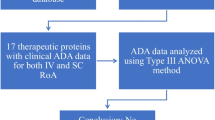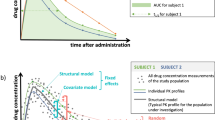Abstract
Background and Objective
Predicting adalimumab pharmacokinetics (PK) for patients impacted by anti-drug antibodies (ADA) has been challenging. The present study assessed the performance of the adalimumab immunogenicity assays in predicting which patients with Crohn’s disease (CD) and ulcerative colitis (UC) have low adalimumab trough concentrations; and aimed to improve predictive performance of adalimumab population PK (popPK) model in CD and UC patients whose PK was impacted by ADA.
Methods
Adalimumab PK and immunogenicity data obtained from 1459 patients in SERENE CD (NCT02065570) and SERENE UC (NCT02065622) were analyzed. Adalimumab immunogenicity was assessed using electrochemiluminescence (ECL) and enzyme-linked immunosorbent (ELISA) assays. From these assays, three analytical approaches (ELISA concentrations, titer, and signal-to-noise [S/N] measurements) were tested as predictors for classifying patients with/without low concentrations potentially affected by immunogenicity. The performance of different thresholds for these analytical procedures was assessed using receiver operating characteristic curves and precision-recall curves. Based on the results from the most sensitive immunogenicity analytical procedure, patients were classified into PK-not-ADA-impacted and PK-ADA-impacted subpopulations. Stepwise popPK modeling was implemented to fit the PK data to an empirical adalimumab two-compartment model with linear elimination and ADA delay compartments to account for the time delay to generate ADA. Model performance was assessed by visual predictive checks and goodness-of-fit plots.
Results
The classical ELISA-based classification (with 20 ng/mL ADA as lower threshold) showed a good balance of precision and recall, to determine which patients had at least 30% adalimumab concentrations below 1 µg/mL. Titer-based classification with the lower limit of quantitation (LLOQ) as threshold showed higher sensitivity to classify these patients compared to the ELISA-based approach. Therefore, patients were classified as PK-ADA-impacted or PK-not-ADA impacted using the LLOQ titer threshold. In the stepwise modeling approach ADA-independent parameters were first fit using PK data from titer-PK-not-ADA-impacted population. The identified ADA-independent covariates included the effect of indication, weight, baseline fecal calprotectin, baseline C-reactive protein, baseline albumin on clearance; and sex and weight on volume of distribution of the central compartment. Pharmacokinetic-ADA-driven dynamics were characterized using PK data for the PK-ADA-impacted population. The categorical covariate based on the ELISA classification was the best at describing the additional effect of immunogenicity analytical approaches on ADA synthesis rate. The model was able to adequately describe the central tendency and variability for PK-ADA-impacted CD/UC patients.
Conclusions
The ELISA assay was found to be optimal for capturing impact of ADA on PK. The developed adalimumab popPK model is robust in predicting PK profiles for CD and UC patients whose PK was impacted by ADA.






Similar content being viewed by others
References
Wadhwa M, Knezevic I, Kang HN, Thorpe R. Immunogenicity assessment of biotherapeutic products: an overview of assays and their utility. Biologicals. 2015;43(5):298–306.
U.S. Department of Health and Human Services, Food and Drug Administration, Center for Drug Evaluation and Research, Center for Biologics Evaluation and Research (CBER). Immunogenicity testing of therapeutic protein products—developing and validating assays for anti-drug antibody detection. Guidance for industry. Silver Spring: Food and Drug Administration; 2019. p. 1–37.
Gomez-Mantilla JD, Troconiz IF, Parra-Guillen Z, Garrido MJ. Review on modeling anti-antibody responses to monoclonal antibodies. J Pharmacokinet Pharmacodyn. 2014;41(5):523–36.
AbbVie Inc. Humira® (adalimumab injection for subcutaneous use) [US package insert]. North Chicago; 2021.
Biotechnology HI-aSopcA, GmbH; 2020. https://www.ema.europa.eu/en/documents/product-information/humira-epar-productinformation_en.pdf. Accessed January 8.
https://www.e-humira.jp/medical/dcd. Humira (adalimumab): Crohn’s disease. Accessed 3 Mar 2023.
Stodtmann S, Chen MJ, Siovitz L, Bereswill M, Lazar A, Croft N, et al. Bridging fixed dose to body weight-based regimen of adalimumab in pediatric ulcerative colitis using a pharmacometric modeling approach: case study with the phase 3 ENVISION I trial. J Crohns Colitis. 2022;16:1551–61.
D’Haens GR, Sandborn WJ, Loftus EV Jr, Hanauer SB, Schreiber S, Peyrin-Biroulet L, et al. Higher vs standard adalimumab induction dosing regimens and 2 maintenance strategies: randomized SERENE CD trial results. Gastroenterology. 2022;162:1876–90.
Panes J, Colombel JF, D’Haens GR, Schreiber S, Panaccione R, Peyrin-Biroulet L, et al. Higher vs standard adalimumab induction and maintenance dosing regimens for treatment of ulcerative colitis: SERENE UC trial results. Gastroenterology. 2022;162:1891–910.
Food and Drug Administration. HUMIRA: clinical pharmacology and biopharmaceutics review(s): FDA; 2008. https://www.accessdata.fda.gov/drugsatfda_docs/bla/2007/125057_S0089.pdf.
Ternant D, Karmiris K, Vermeire S, Desvignes C, Azzopardi N, Bejan-Angoulvant T, et al. Pharmacokinetics of adalimumab in Crohn’s disease. Eur J Clin Pharmacol. 2015;71(9):1155–7.
Sharma S, Eckert D, Hyams JS, Mensing S, Thakkar RB, Robinson AM, et al. Pharmacokinetics and exposure-efficacy relationship of adalimumab in pediatric patients with moderate to severe Crohn’s disease: results from a randomized, multicenter, phase-3 study. Inflamm Bowel Dis. 2015;21(4):783–92.
Berends SE, Strik AS, Van Selm JC, Lowenberg M, Ponsioen CY, D’Haens GR, et al. Explaining interpatient variability in adalimumab pharmacokinetics in patients with Crohn’s disease. Ther Drug Monit. 2018;40(2):202–11.
VandeCasteele N, Baert F, Bian S, Dreesen E, Compernolle G, Van Assche G, et al. Subcutaneous absorption contributes to observed interindividual variability in adalimumab serum concentrations in Crohn’s disease: a prospective multicentre study. J Crohns Colitis. 2019;13(10):1248–56.
Sanchez-Hernandez JG, Perez-Blanco JS, Rebollo N, Munoz F, Prieto V, Calvo MV. Biomarkers of disease activity and other factors as predictors of adalimumab pharmacokinetics in inflammatory bowel disease. Eur J Pharm Sci. 2020;150: 105369.
Marquez-Megias S, Ramon-Lopez A, Mas-Serrano P, Diaz-Gonzalez M, Candela-Boix MR, Nalda-Molina R. Evaluation of the predictive performance of population pharmacokinetic models of adalimumab in patients with inflammatory bowel disease. Pharmaceutics. 2021;13(8):1244.
Chen X, Hickling T, Kraynov E, Kuang B, Parng C, Vicini P. A mathematical model of the effect of immunogenicity on therapeutic protein pharmacokinetics. AAPS J. 2013;15(4):1141–54.
Kamath U, Liu J. Explainable artificial intelligence: an introduction to interpretable machine learning. Cham: Springer; 2021. p. 333.
Acknowledgements
Medical writing support was provided by Mia DeFino, MS, ELS, a freelance medical writer under contract with AbbVie. Programming support was provided by Rainer Hans Krauss. Peter Noertersheuser contributed modeling ideas for the impact of immunogenicity on PK.
Author information
Authors and Affiliations
Corresponding author
Ethics declarations
Conflict of interest
All authors are employees at AbbVie and may hold AbbVie stock.
Funding
AbbVie provided financial support for the studies and participated in the study design, study conduct, and analysis and interpretation of data and the writing, review, and approval of the manuscript.
Ethics approval
The studies were conducted in accordance with Good Clinical Practice Guidelines and the ethical principles that have their origin in the Declaration of Helsinki. The protocols were approved by the institutional review board or ethics committee for each site.
Consent to participate
Each subject provided written informed consent before any study-related procedures were performed.
Consent for publication
All authors provided consent for publication.
Data availability
AbbVie is committed to responsible data sharing regarding the clinical trials we sponsor. This includes access to anonymized, individual, and trial-level data (analysis data sets), as well as other information (e.g., protocols and Clinical Study Reports), as long as the trials are not part of an ongoing or planned regulatory submission. This includes requests for clinical trial data for unlicensed products and indications. This clinical trial data can be requested by any qualified researchers who engage in rigorous, independent scientific research and will be provided following review and approval of a research proposal and Statistical Analysis Plan (SAP) and execution of a Data Sharing Agreement (DSA). Data requests can be submitted at any time, and the data will be accessible for 12 months, with possible extensions considered. For more information on the process or to submit a request, visit the following link: https://www.abbvie.com/our-science/clinical-trials/clinical-trials-data-and-information-sharing/data-and-information-sharing-with-qualified-researchers.html.
Code availability
Not available.
Author contributions
AVPB, MJC, and SS wrote the manuscript. AVPB, MJC, SS, NM, IW, SM, JB, TH, and ID analyzed data, performed research, and contributed new analytical tools. AVPB, SS, NM, JB, TH, and ID designed research. LL supervised analysis and research for both studies.
Supplementary Information
Below is the link to the electronic supplementary material.
Rights and permissions
Springer Nature or its licensor (e.g. a society or other partner) holds exclusive rights to this article under a publishing agreement with the author(s) or other rightsholder(s); author self-archiving of the accepted manuscript version of this article is solely governed by the terms of such publishing agreement and applicable law.
About this article
Cite this article
Ponce-Bobadilla, A.V., Stodtmann, S., Chen, MJ. et al. Assessing the Impact of Immunogenicity and Improving Prediction of Trough Concentrations: Population Pharmacokinetic Modeling of Adalimumab in Patients with Crohn’s Disease and Ulcerative Colitis. Clin Pharmacokinet 62, 623–634 (2023). https://doi.org/10.1007/s40262-023-01221-x
Accepted:
Published:
Issue Date:
DOI: https://doi.org/10.1007/s40262-023-01221-x




